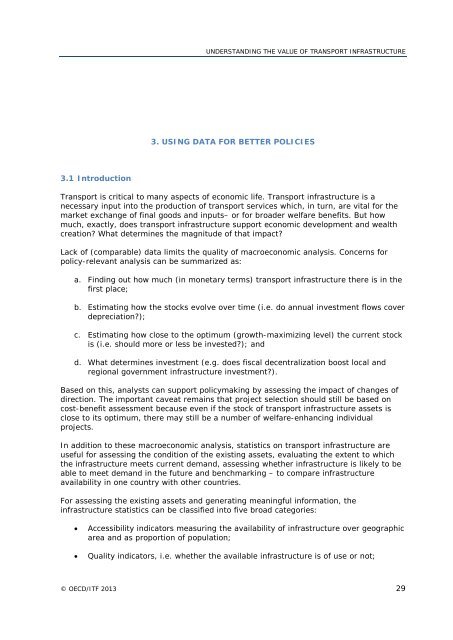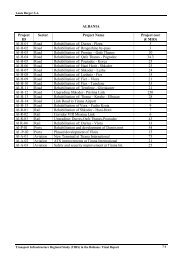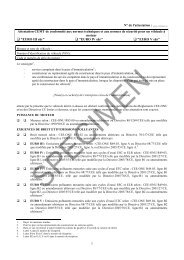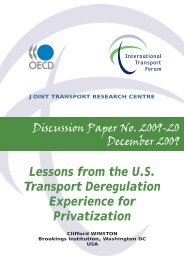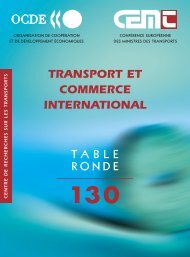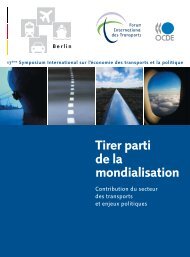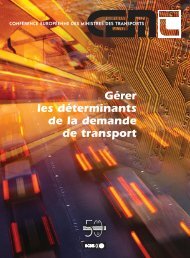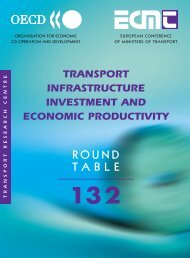Understanding the Value of Transport Infrastructure ...
Understanding the Value of Transport Infrastructure ...
Understanding the Value of Transport Infrastructure ...
Create successful ePaper yourself
Turn your PDF publications into a flip-book with our unique Google optimized e-Paper software.
UNDERSTANDING THE VALUE OF TRANSPORT INFRASTRUCTURE<br />
3. USING DATA FOR BETTER POLICIES<br />
3.1 Introduction<br />
<strong>Transport</strong> is critical to many aspects <strong>of</strong> economic life. <strong>Transport</strong> infrastructure is a<br />
necessary input into <strong>the</strong> production <strong>of</strong> transport services which, in turn, are vital for <strong>the</strong><br />
market exchange <strong>of</strong> final goods and inputs– or for broader welfare benefits. But how<br />
much, exactly, does transport infrastructure support economic development and wealth<br />
creation? What determines <strong>the</strong> magnitude <strong>of</strong> that impact?<br />
Lack <strong>of</strong> (comparable) data limits <strong>the</strong> quality <strong>of</strong> macroeconomic analysis. Concerns for<br />
policy-relevant analysis can be summarized as:<br />
a. Finding out how much (in monetary terms) transport infrastructure <strong>the</strong>re is in <strong>the</strong><br />
first place;<br />
b. Estimating how <strong>the</strong> stocks evolve over time (i.e. do annual investment flows cover<br />
depreciation?);<br />
c. Estimating how close to <strong>the</strong> optimum (growth-maximizing level) <strong>the</strong> current stock<br />
is (i.e. should more or less be invested?); and<br />
d. What determines investment (e.g. does fiscal decentralization boost local and<br />
regional government infrastructure investment?).<br />
Based on this, analysts can support policymaking by assessing <strong>the</strong> impact <strong>of</strong> changes <strong>of</strong><br />
direction. The important caveat remains that project selection should still be based on<br />
cost-benefit assessment because even if <strong>the</strong> stock <strong>of</strong> transport infrastructure assets is<br />
close to its optimum, <strong>the</strong>re may still be a number <strong>of</strong> welfare-enhancing individual<br />
projects.<br />
In addition to <strong>the</strong>se macroeconomic analysis, statistics on transport infrastructure are<br />
useful for assessing <strong>the</strong> condition <strong>of</strong> <strong>the</strong> existing assets, evaluating <strong>the</strong> extent to which<br />
<strong>the</strong> infrastructure meets current demand, assessing whe<strong>the</strong>r infrastructure is likely to be<br />
able to meet demand in <strong>the</strong> future and benchmarking – to compare infrastructure<br />
availability in one country with o<strong>the</strong>r countries.<br />
For assessing <strong>the</strong> existing assets and generating meaningful information, <strong>the</strong><br />
infrastructure statistics can be classified into five broad categories:<br />
• Accessibility indicators measuring <strong>the</strong> availability <strong>of</strong> infrastructure over geographic<br />
area and as proportion <strong>of</strong> population;<br />
• Quality indicators, i.e. whe<strong>the</strong>r <strong>the</strong> available infrastructure is <strong>of</strong> use or not;<br />
© OECD/ITF 2013 29


